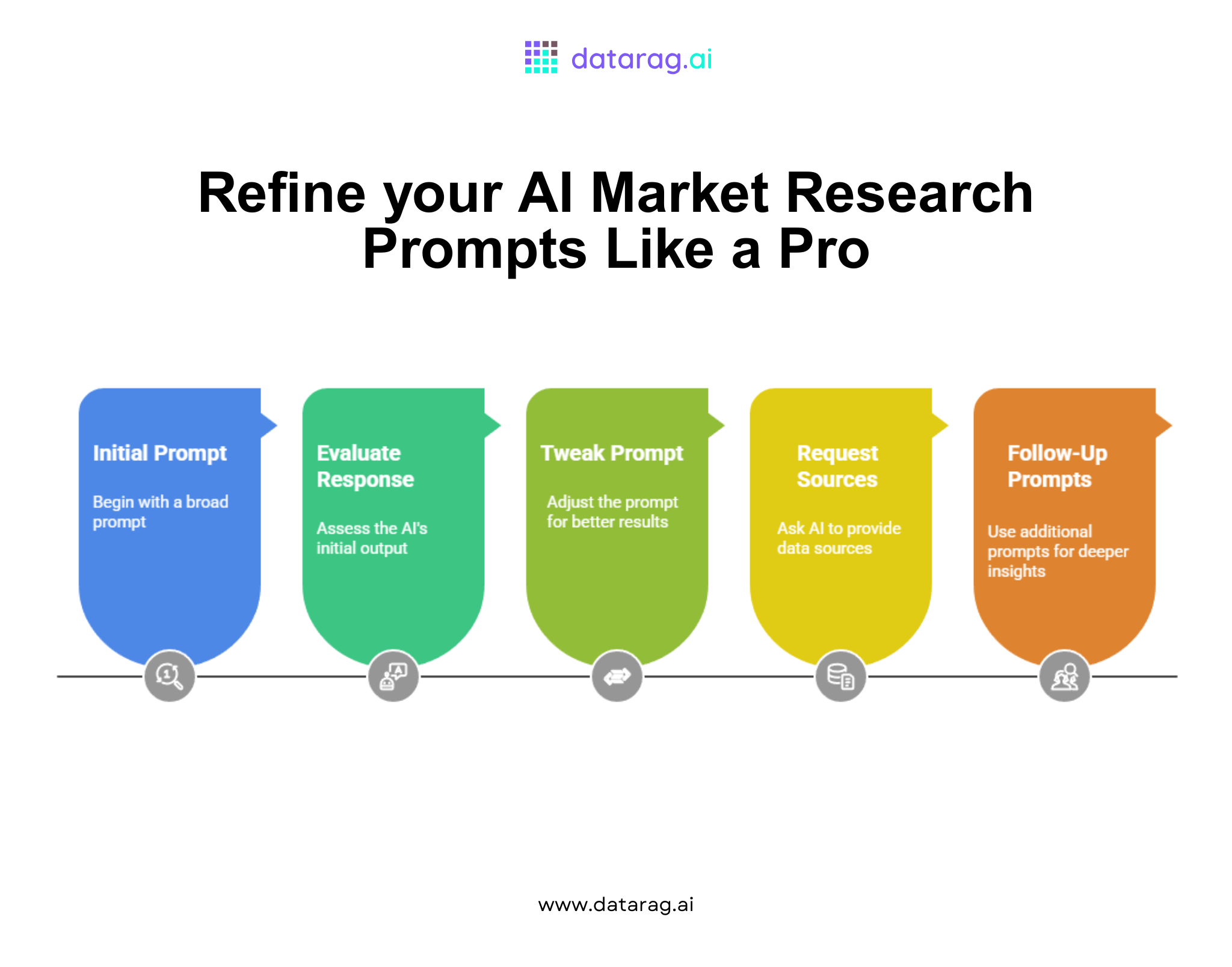If you’re still not using AI for market research, no need to keep torturing yourself and spending tens of hours going through a bazillion Google results. AI tools are great for speeding up the process, but only if you know how to ask the right questions.
A vague prompt leads to vague (or worse, inaccurate) answers. The key? Structured prompts that force AI to deliver high-quality, actionable insights.
In this guide, you’ll learn:
✅ The 4-part framework for crafting perfect AI prompts (with examples)
✅ 5 must-have AI prompts for market research (ready to copy-paste).
✅ Pro tips to refine AI responses for better accuracy.
✅ A free cheat sheet of optimized prompts for market research.
What Makes A Great AI Market Research Prompt?
A strong AI prompt follows this 4-part framework:
Goal – What do you want to know? (The more specific, the better!)
Return Format – How should the answer be structured? (Bullet points, table, summary, etc.)
Warnings – Any restrictions or red flags? (Avoid outdated data, fake sources, etc.)
Context Dump – Extra details to refine the answer. (Target audience, industry, product details, etc.)
❌ Weak Prompt vs. ✅ Strong Prompt
The strong prompt forces AI to give precise, data-backed answers—no fluff or vague responses.
5 Must-Have AI Prompts for Market Research (With Examples)
Prompt 1: Competitor Analysis
Use Case: "I need to understand my competitors’ strengths and weaknesses."
Example Prompt:
Goal: "Identify the top 3 competitors of [Your Brand] in the [Industry] and compare their pricing, messaging, and customer reviews."
Return Format: "Present the data in a table with columns for Competitor, Pricing Strategy, Key Messaging, and Common Customer Complaints."
Warnings: "Exclude outdated data (older than 12 months) and focus on premium brands located in the US."
Context Dump: "We sell premium organic skincare; focus on U.S.-based competitors."
Why It Works:
✔ Forces AI to compare real competitors (not just list them)
✔ Table format makes data easy to scan
✔ Filters out old, irrelevant data
Prompt 2: Customer Sentiment Analysis
Use Case: "What do people really think about my product?"
Example Prompt:
Goal: "Summarize the sentiment of customer reviews for [Product] on Amazon and Trustpilot."
Return Format: "Provide a short paragraph summary followed by 3 key positive and 3 key negative themes."
Warnings: "Flag any recurring complaints about shipping or quality."
Context Dump: "Our product is a wireless earphone priced at $99."
Why It Works:
✔ Extracts both positive and negative trends
✔ Highlights urgent issues (like shipping delays)
✔ Avoids vague statements like "Customers are happy."
Prompt 3: Trend Forecasting
Use Case: "What emerging trends should I prepare for?"
Example Prompt:
Goal: "Predict the top 3 emerging trends in [Industry] for 2025 based on recent news and reports."
Return Format: "Ranked list with 1-2 sentences explaining each trend and its potential impact."
Warnings: "Prioritize trends with at least three credible sources, such as X, Y, Z."
Context Dump: "We’re a B2B SaaS company in project management software."
Why It Works:
✔ Forces AI to cite credible sources (no made-up trends)
✔ Ranks by importance (not just random predictions)
✔ Helps you stay ahead of competitors and make informed decisions about your future content ideas.
Prompt 4: Target Audience Profiling
Use Case: "Who exactly is buying my product?"
Example Prompt:
Goal: "Create a detailed profile of the ideal customer for [Product], including demographics, pain points, and buying habits."
Return Format: "Bullet points under headings: Demographics, Psychographics, Challenges, and Preferred Communication Channels."
Warnings: "Avoid generic descriptions; focus on data-backed insights."
Context Dump: "Our product is a $29/month AI writing tool for marketers."
Why It Works: ✔ Avoids vague personas like *"women aged 18-35"*
✔ Identifies real pain points (not assumptions)
✔ Helps tailor ads, messaging, and product features
Prompt 5: Pricing Strategy Insights
Use Case: "How should I price my new product?"
Example Prompt:
Goal: "Analyze competitor pricing for [Product Category] and recommend a pricing strategy for our new product."
Return Format: "Start with a comparison table, then suggest 3 pricing models with pros/cons."
Warnings: "Highlight gaps where competitors are over- or underpricing."
Context Dump: "Our product has advanced features but targets budget-conscious small businesses."
Why It Works:
✔ Compares real market prices (not guesses)
✔ Recommends data-backed strategies (freemium, subscription, one-time fee)
✔ Finds pricing gaps to exploit

Free Cheat Sheet: 10 Ready-to-Use Market Research Prompts
Takeaway
Better prompts = better insights. Always include:
✔ Goal (What do you need?)
✔ Return Format (How should it be structured?)
✔ Warnings (Any red flags to avoid?)
✔ Context Dump (Extra details for precision)
Time to get more efficient with your market research.
Check out Datarag AI’s ready-to-use prompts—save time and get accurate, structured insights instantly. Plus, organize your chat history for quick access.
Which prompt will you try first? Let us know in the comments!